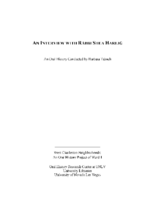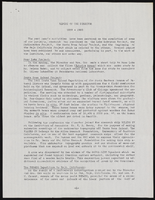Search the Special Collections and Archives Portal
Search Results

Transcript of interview with Rabbi Shea Harlig by Barbara Tabach, March 5, 2014
Date
Archival Collection
Description
Interview with Rabbi Shea Harlig by Barbara Tabach on March 5, 2014. In this interview, Rabbi Harlig discusses the Chabad movement of Orthodox Judaism and establishment of Chabad centers in Las Vegas and Southern Nevada. Rabbi Harlig talks about the property he has acquired for Chabad, and its outreach programs, including supervision of kosher kitchens in hotels. This interview was conducted for the Ward 1: West Charleston Neighborhoods oral history project, and therefore includes zoning and neighborhood discrimination issues, and a tour of the property.
Rabbi Shea Harlig arrived in Las Vegas in 1990 and settled in the Artesian Heights neighborhood of Las Vegas. As Director of Chabad of Southern Nevada, Rabbi Harlig focuses on religious outreach, education and social services, and has helped establish seven Chabad locations throughout the community and also built a school and educational program of the highest standards.
Text
T-Shirt Color: White; Front: World Trade Center Benefit, F.O.P. Lodge #8, Sept.22, 2001; Back: World Trade center Benefit, For Our Fallen Brothers & Sisters Of NYC, USA & Red, White, & Blue; Handwritten Text: We Will Never Forget, Virginia Beach Police/Fire; Chris Fox, VBPD; Marcie Fox, VBPD; Beverly Mahoney; Shawn Mahoney, VBPD; 2-14-02, approximately 2001-2012
Level of Description
Archival Collection
Collection Name: New York-New York Hotel and Casino 9-11 Heroes Tribute Collection
Box/Folder: Box 369
Archival Component
T-Shirt Color: White; Front: Chicago F.D., Truck 27, Eng. 62, Batt. 22, Dept. Emblem With Fire Hat; Back: Bad Boys Of Roseland At The Oasis, Four Firefighters Sunbathing Under Palm Trees.; Handwritten Text: Numerous Names: Chicago Fire, Eng. 62, Truck 27; Tom Schergen, Ed Cerdan, Frank McCann, Mike Walsh, Bob Kawa, Tim Carpool, approximately 2001-2012
Level of Description
Archival Collection
Collection Name: New York-New York Hotel and Casino 9-11 Heroes Tribute Collection
Box/Folder: Box 340
Archival Component
Myers, W. A., 1997, "Environmental Impact Statement (EIS) for the F-22 Follow-on Operational Testing and Evaluation and Weapons School Beddown, Nellis AFB, Nevada." memorandum with attachment to W. Dixon (Yucca Mountain Site Characterization Office, U. S. Department of Energy), received April 1997, Chief, Environmental Planning Division. Environmental Conservation and Planning Directorate, U. S. Air Force, Headquarters, Air Force Center for Environmental Excellence. Brooks Air Force Base, Texas, 1997
Level of Description
Archival Collection
Collection Name: Environmental Radiation Protection Standards for Yucca Mountain, Nevada
Box/Folder: Box 24
Archival Component

Transcript of interview with Theda Kay Grinnell by Fletcher Corey, February 28, 1977
Date
Archival Collection
Description
On February 28, 1977, Fletcher Corey interviewed Theda Kay Grinnell (born 1935 in New London, Iowa) about her life in Las Vegas, Nevada. Grinnell first talks about her move to Nevada and both her and her husband’s work at the Nevada Test Site. She also talks about the atomic blasts, competition with Russia, and her employment that followed her work at the Test Site. Grinnell later talks about her church membership and goes into detail about the race riots and how they involved and impacted her and her son. The end of the interview includes discussion on flash floods, the culinary union, how World War II affected the Las Vegas industry, and the social changes in Las Vegas.
Text

Transcript of interview with Mary Habbart by David Patt, March 7, 1975
Date
Archival Collection
Description
On March 7, 1975, collector David R. Patt interviewed dairy and vegetable farm owner, Mary Habbart (born January 1st, 1719 in Boothwyn, Pennsylvania) in her home in Las Vegas, Nevada. This interview offers an overview of life in Las Vegas in the early days, which included: atomic testing, floods, prostitution on Block 16, early Fremont Street and Duck Creek. Also discussed during this interview: Sunset Park, The Roosevelts, Bugsy Siegel, local government and the Hoover Dam.
Text
An Interview with Katherine M. Joseph
Identifier
Abstract
Oral history interview with Katherine M. Joseph conducted by Claytee D. White on October 25, 2004 and September 05, 2007 for the African Americans in Las Vegas: a Collaborative Oral History Project. Joseph discusses dancing in Paris, France with Josephine Baker and working at the Moulin Rouge Hotel and Casino during its heyday. Joseph also discusses race segregation in Las Vegas, Nevada in the 1950s and of the burgeoning and bustling African-American communities and neighborhoods.
Archival Collection

Hildred Meidell interview, February 27, 1979: transcript
Date
Archival Collection
Description
On February 27, 1979, collector Greg Abbott interviewed Hildred Meidell (b. March 17, 1900 in Webb City, Missouri) about her time living in Las Vegas, Nevada. Meidell covers a range of topics, from her and her husband’s time as tourists in the city and their subsequent retirement to Las Vegas from Los Angeles, California. Meidell describes the Las Vegas Strip, the interstate and highway conditions between Los Angeles and Las Vegas, as well as their numerous visits to Hoover Dam (Boulder Dam). Moreover, she speaks about the changing layout of the city, the increase in shopping centers and department stores, and the clothing stores inside of hotels. Lastly, Meidell talks about the prominence of churches in local communities, the atomic testing program and the structural damages these tests caused in her neighborhood, and the influence of the railroad and passenger train on the town.
Text

Letter from Walter R. Bracken (Las Vegas) to Frank Strong (Los Angeles), July 15, 1941
Date
Archival Collection
Description
Bracken reporting to Strong that in relation to the water due to the Stewart family, a miner's inch equals 11.22 gallons per minute.
Text

